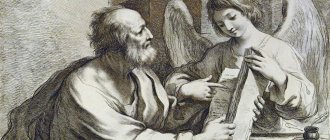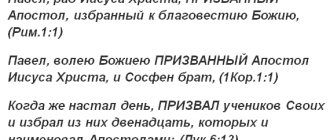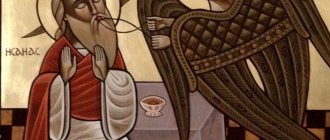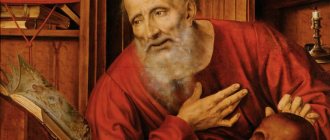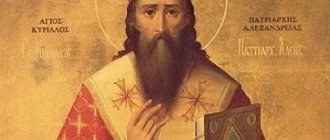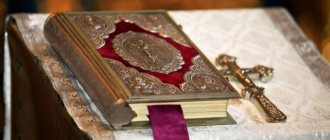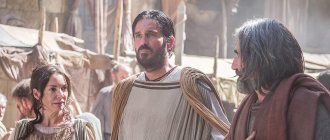Mark is one of the seventy apostles. Those who preached Christianity in the 1st century. The biography of Evangelist Mark includes many travels related to missionary work. The life of the saint is known from the texts of the New Testament and the testimonies of ancient writers. The saint was present at the arrest of Christ and will transfer memories of this to the pages of his Gospel.
Painting by artist Valentin de Boulogne “The Apostle Mark”, 17th century
Matthew, Luke, Mark, John are the holy evangelists whose books were included in the New Testament. Preaching Christianity, everyone except John suffered martyrdom. Saint Matthew is considered the author of the first Gospel.
The biography of Evangelist Mark includes many travels related to missionary work. Apostle Luke was the first icon painter. Saint John wrote five books for the New Testament.
Who are the apostles? 12 disciples of Christ
The son of Paul and Mary, the future apostle Mark, was born in Cyrene (modern Libya). Soon after his birth, the family moved to Jerusalem. Upon his birth, he received the double name John-Mark. John is a Hebrew name, Mark is a Latin name.
The apostle came from a family of priests, from the tribe of Levi. He was born into a wealthy family, which provided the saint with a good education. He studied Hebrew, Greek, and Latin.
In Jerusalem, Mark's mother, Mary, becomes one of the first followers of Jesus Christ. Christians who believed in Him gathered in her house, so Mark joined the community of Jesus as a young man. There is a legend that the Last Supper itself took place in the house of Mark’s mother.
"The Last Supper" by Leonardo da Vinci. According to legend, it took place in the house of Mary, mother of Mark
Later, when the apostle writes the Gospel, in the story of the arrest of Christ he will mention one young man. According to legend, Mark is believed to be describing himself.
“One young man, wrapped in a veil over his naked body, followed Him; and the soldiers seized him. But he left the veil and ran away from them naked.”
(Mark 14:51-52)
Pavel Popov, “Taking Christ into custody.” A naked youth running away from the guards - seventeen-year-old Apostle Mark
After the ascension of Jesus to heaven, during the persecution of Christians, the house of the saint’s mother served as a refuge for some of the apostles. It also became a temporary home for the Apostle Peter, who later experienced warm fatherly feelings for Mark and called him “my son” in his letters. And Saint Barnabas, who was Mark’s uncle, introduced his nephew to the Apostle Paul.
Apostle Barnabas, uncle and closest friend of Saint Mark. We preached Christianity together for several years
In the early 40s. Barnabas takes his nephew on a missionary journey led by the Apostle Paul. Together with them, Saint Mark was in Seleucia, then set off on the journey to the island of Crete. His apostle walked all the way from east to west. From there he went to Jerusalem, and then visited Rome with the Apostle Peter.
The Apostle Peter was Mark's teacher. During his missionary work in Rome, Mark was his translator and assistant in the formation of the Christian community
In Rome, Peter and Mark found an already existing Christian community. The Apostle Peter multiplied the Roman church with his word and miracles, and Mark became his right hand. Mark acted as an interpreter between Peter, who spoke little Greek, and his listeners.
Saint Mark carried out his missionary work among the Jewish diaspora in Rome, which numbered about 45 thousand people.
4 evangelists
It was in Rome, according to many, that Mark wrote the Gospel for the pagans and those who believed in Him. Church writers of the time testify that the Gospel of Mark is a record of Peter's stories. Peter himself will confirm the accuracy and truthfulness of the book compiled by Mark and approve it for reading in the churches.
Gospel of Mark, first page in handwritten version
At the behest of his older friend and comrade, Mark went to Egypt.
In Alexandria the saint founded a church and became the first bishop of Alexandria. In this city, the apostle compiled the rite of the Liturgy for Christians and actually created the church hierarchy. In Alexandria, he founded a school, from which such famous church fathers as Gregory the Wonderworker, Clement of Alexandria, St. Dionysius and others subsequently emerged.
Clement of Alexandria was educated at a Christian school founded by St. Mark
The Liturgy of St. Mark is a classic example of Alexandrian worship. Due to its brevity and clarity, it was popular in many places in the Christian world until the 12th century. Then it was supplanted by the Liturgy of Byzantine origin.
After the evangelist Mark laid the foundations of the church, many Egyptians abandoned paganism and embraced Christianity, which caused concern in Rome.
Mark is the first bishop and first martyr of the Alexandrian Church.
On April 25, 68, the holiday of Holy Easter coincided with the celebration in honor of the Egyptian god Serapis. On this day, the pagans seized Mark in the temple during worship, beat him and threw him into prison.
The next day, a rope was tied around the saint’s neck, and the other end was tied to a bull. The animal was driven through the streets all day. The wounded Mark was dragged along the ground behind him. By evening, all the streets of the city were covered in the blood of the apostle. Then he was untied and put back in prison.
Martyrdom of Saint Mark. The pagans tied Mark up and dragged him through the streets of the city for several days.
At night, Jesus appeared to Mark and said that he would die tomorrow. In the morning the torture was repeated. The bull dragged the saint on a rope until his head was torn away from his body. Then the Christians took the body of the Holy Apostle and his head and buried it. In the 4th century AD. A church was built over the tomb of St. Mark.
Gospel of St. Mark
Mark, Luke, Matthew, John are the holy evangelists whose books were included in the New Testament. Preaching Christianity, everyone except John suffered martyrdom.
Evangelists. From left to right, top to bottom: Matthew, John, Luke, Mark
The Gospel of Mark is the second book of the New Testament. But some contemporaries believe that the Gospel of Mark was the first of the canonical Gospels and became the basis for writing the good news of Luke and Matthew.
The Gospel was written around the 60-70s.
The Holy Gospel of Mark is the shortest of the four. It is divided into 2 parts and consists of 16 chapters. It was written in Greek and in a colloquial style. The first eight chapters show stories of Christ's miracles to prove that he is the son of God.
For this reason, the lion was chosen as the symbol of St. Mark. The lion rises above other animals, just as Jesus Christ is presented in the Gospel of Mark as omnipotent and royal.
The Apostle Mark and his symbol is the royal lion. This is exactly how Mark described Jesus in his Gospel: omnipotent and all-powerful.
There are two versions of the place of writing - Rome and Alexandria.
Back in 200, Clement of Alexandria declared that the apostle’s good news was written in Rome. There are a number of factors that confirm his words:
- Mark is the only evangelist who uses several typical Roman words in Greek.
- The apostle uses Latin words and expressions that were used in Rome.
- The Gospel of Mark contains no details of Jewish life.
- Uses the Roman time system.
- The Gospel is written in Greek to reach the largest possible audience. At that time, Greek was considered an international language.
In the Gospel of Mark, more attention is paid to the actions of Christ, and not to his speeches. The resurrection of Christ and the meeting with the disciples in Galilee are written with special feeling.
“Finally, he appeared to the eleven themselves, who were reclining at supper, and reproached them for their unbelief and hardness of heart, because they did not believe those who saw Him risen. And he said to them: Go ye into all the world and preach the gospel to every creature.” (Mark 16:14-15)
Purposes of the Gospel of Mark:
- Evidence that Jesus Christ is the son of God.
- Strengthening the faith of newly converted Christians and instructing them.
- Attracting new followers to the Christian faith.
But also for the first generations of Christians it was important not only to show the divine level of Christ, but also to insist that he was a man, otherwise his suffering was ridiculous. In the second part of the Gospel, Mark describes the words of Jesus explaining the need for atonement for human sins by death on the cross.
Prayers
Troparion, tone 3
[3]
Having learned from the supreme Peter,/ you were an apostle of Christ/ and, like the sun of the countries, you became a blessing to Alexandria, blessed:/ by you Egypt was freed from delusion,/ by your gospel enlightened everything with honor,/ like a light, a pillar of the church./ For this reason We honor your memory, we brightly celebrate,/ Marco, God-Glass,/ pray to God with the gospel, // that forgiveness of sins may be granted to our souls
.
Kontakion, tone 2
From on high we receive the grace of the Spirit,/ you destroyed the rhetorical weaving, O apostle,/ and, having caught all the tongues, O all-glorious Marco,/ you brought to your Master,// Having preached the Divine Gospel
.
- Troparion, tone 4, from the Greek Menaion [4]
Petrov, a traveler/ and a sacred companion,/ the words of a servant and a wise seer/ appeared to you, O apostle./ Moreover, the Divine Good News of the Savior, Marke, inscribed,/ as it is hidden heavenly servant.// For this reason, evangelist, we magnify you with love
.
St. Mark's Basilica in Venice
In 828, Egypt is ruled by Muslim Arabs who destroy Christian temples to build mosques. Venetian merchants took upon themselves the mission to save the holy relics from desecration and transport them to their homeland. In Aquileia, Mark was especially revered as the founder of the Christian community.
According to legend, the merchants took the sacred relic, carried it to their ship and covered it with pork carcasses. The Muslims who checked the goods disdained to touch them. So the relics of the saint were transported to the Adriatic, to the Cathedral of St. Mark. Previously, the saint’s relics were kept in the lower part of the temple; now they rest in a stone sarcophagus in the altar of the cathedral.
St. Mark's Cathedral in Venice on the main and only square of the city
From that time on, Apostle Mark and Venice were inseparable. The Lion of Mark became the state symbol of Venice; it adorns the city flag. Since that time, the Apostle Mark and Venice have been inseparable. The Lion of Mark has become the state symbol of Venice; it adorns the city flag.
Flag of Venice with the symbol of St. Mark - the lion
The Orthodox and Catholic churches celebrate the saint's feast day on April 25 according to the Eastern calendar.
Passage characterizing the Apostle Mark
“After all, this is our Tikhon,” said the esaul. - He! they are! “What a rogue,” Denisov said. - He will go away! - Esaul said, narrowing his eyes. The man they called Tikhon, running up to the river, splashed into it so that splashes flew, and, hiding for a moment, all black from the water, he got out on all fours and ran on. The French running after him stopped. “Well, he’s clever,” said the esaul. - What a beast! – Denisov said with the same expression of annoyance. - And what has he been doing so far? - Who is this? – Petya asked. - This is our plastun. I sent him to take the tongue. “Oh, yes,” Petya said from Denisov’s first word, nodding his head as if he understood everything, although he absolutely did not understand a single word. Tikhon Shcherbaty was one of the most necessary people in the party. He was a man from Pokrovskoye near Gzhat. When, at the beginning of his actions, Denisov came to Pokrovskoye and, as always, calling the headman, asked what they knew about the French, the headman answered, as all the headmen answered, as if defending themselves, that they didn’t know anything, to know they don't know. But when Denisov explained to them that his goal was to beat the French, and when he asked if the French had wandered in, the headman said that there were definitely marauders, but that in their village only one Tishka Shcherbaty was involved in these matters. Denisov ordered Tikhon to be called to him and, praising him for his activities, said a few words in front of the headman about the loyalty to the Tsar and the Fatherland and the hatred of the French that the sons of the Fatherland should observe. “We don’t do anything bad to the French,” said Tikhon, apparently timid at Denisov’s words. “That’s the only way we fooled around with the guys.” They must have beaten about two dozen Miroders, otherwise we didn’t do anything bad... - The next day, when Denisov, completely forgetting about this guy, left Pokrovsky, he was informed that Tikhon had joined the party and asked to be left with it. Denisov ordered to leave him. Tikhon, who at first corrected the menial work of laying fires, delivering water, skinning horses, etc., soon showed greater willingness and ability for guerrilla warfare. He went out at night to hunt for prey and each time brought with him French clothes and weapons, and when he was ordered, he also brought prisoners. Denisov dismissed Tikhon from work, began to take him with him on travels and enrolled him in the Cossacks. Tikhon did not like to ride and always walked, never falling behind the cavalry. His weapons were a blunderbuss, which he wore more for fun, a pike and an ax, which he wielded like a wolf wields his teeth, equally easily picking out fleas from his fur and biting through thick bones. Tikhon equally faithfully, with all his might, split logs with an ax and, taking the ax by the butt, used it to cut out thin pegs and cut out spoons. In Denisov's party, Tikhon occupied his special, exclusive place. When it was necessary to do something especially difficult and disgusting - turn a cart over in the mud with your shoulder, pull a horse out of a swamp by the tail, skin it, climb into the very middle of the French, walk fifty miles a day - everyone pointed, laughing, at Tikhon. “What the hell is he doing, you big gelding,” they said about him. Once, the Frenchman whom Tikhon was taking shot at him with a pistol and hit him in the flesh of his back. This wound, for which Tikhon was treated only with vodka, internally and externally, was the subject of the funniest jokes in the entire detachment and jokes to which Tikhon willingly succumbed. - What, brother, won’t you? Is Ali crooked? - the Cossacks laughed at him, and Tikhon, deliberately crouching and making faces, pretending that he was angry, scolded the French with the most ridiculous curses. This incident had only the influence on Tikhon that after his wound he rarely brought prisoners. Tikhon was the most useful and brave man in the party. No one else discovered cases of attack, no one else took him and beat the French; and as a result of this, he was the jester of all the Cossacks and hussars and he himself willingly succumbed to this rank. Now Tikhon was sent by Denisov, at night, to Shamshevo in order to take the tongue. But, either because he was not satisfied with just the Frenchman, or because he slept through the night, during the day he climbed into the bushes, into the very middle of the French and, as Denisov saw from Mount Denisov, was discovered by them. After talking a little more time with the esaul about tomorrow's attack, which now, looking at the proximity of the French, Denisov seemed to have finally decided, he turned his horse and rode back. “Well, darling, now let’s go dry off,” he said to Petya. Approaching the forest guardhouse, Denisov stopped, peering into the forest. Through the forest, between the trees, a man in a jacket, bast shoes and a Kazan hat, with a gun over his shoulder and an ax in his belt, walked with long, light steps on long legs, with long, dangling arms. Seeing Denisov, this man hastily threw something into the bush and, taking off his wet hat with its drooping brim, approached the boss. It was Tikhon. His face, pitted with smallpox and wrinkles, with small, narrow eyes, shone with self-satisfied gaiety. He raised his head high and, as if holding back laughter, stared at Denisov. - Well, where did you fall? - Denisov said. - Where had you been? “I followed the French,” Tikhon answered boldly and hastily in a hoarse but melodious bass. - Why did you climb during the day? Cattle! Well, didn’t you take it?.. “I took it,” said Tikhon. - Where is he? “Yes, I took him first at dawn,” Tikhon continued, moving his flat legs turned out wider in his bast shoes, “and took him into the forest.” I see it's not okay. I think, let me go and get another more careful one. “Look, you scoundrel, that’s how it is,” Denisov said to the esaul. - Why didn’t you do this? “Why should we lead him,” Tikhon interrupted hastily and angrily, “he’s not fit.” Don't I know which ones you need? “What a beast!.. Well?..” “I went after someone else,” Tikhon continued, “I crawled into the forest in this manner, and then lay down.” – Tikhon suddenly and flexibly lay down on his belly, imagining in their faces how he did it. “One and catch up,” he continued. “I’ll rob him in this manner.” – Tikhon quickly and easily jumped up. “Let’s go, I say, to the colonel.” How loud he will be. And there are four of them here. They rushed at me with skewers. “I hit them with an ax in this manner: why are you, Christ is with you,” Tikhon cried, waving his arms and frowning menacingly, sticking out his chest. “We saw from the mountain how you asked a line through the puddles,” said the esaul, narrowing his shining eyes. Petya really wanted to laugh, but he saw that everyone was holding back from laughing. He quickly moved his eyes from Tikhon’s face to the faces of the esaul and Denisov, not understanding what it all meant. “You can’t imagine it,” Denisov said, coughing angrily. – Why didn’t peg’vogo pg’ivel? Tikhon began to scratch his back with one hand, his head with the other, and suddenly his whole face stretched into a shining, stupid smile, revealing a missing tooth (for which he was nicknamed Shcherbaty). Denisov smiled, and Petya burst into cheerful laughter, which Tikhon himself joined in. “Yes, it’s completely wrong,” said Tikhon. “The clothes he’s wearing are bad, so where should we take him?” Yes, and a rude man, your honor. Why, he says, I myself am the son of Anaral, I won’t go, he says. - What a brute! - Denisov said. “I need to ask…” “Yes, I asked him,” said Tikhon. - He says: I don’t know him well. There are many of ours, he says, but all of them are bad; only, he says, one name. “If you’re fine,” he says, “you’ll take everyone,” Tikhon concluded, looking cheerfully and decisively into Denisov’s eyes. “Here, I’ll pour in a hundred of them, and you’ll do the same,” Denisov said sternly. “Why be angry,” said Tikhon, “well, I haven’t seen your French?” Just let it get dark, I’ll bring whatever you want, at least three. “Well, let’s go,” Denisov said, and he rode all the way to the guardhouse, frowning angrily and silently. Tikhon came from behind, and Petya heard the Cossacks laughing with him and at him about some boots that he had thrown into a bush. When the laughter that had taken over him at Tikhon’s words and smile passed, and Petya realized for a moment that this Tikhon had killed a man, he felt embarrassed. He looked back at the captive drummer, and something pierced his heart. But this awkwardness lasted only for a moment. He felt the need to raise his head higher, cheer up and ask the esaul with a significant look about tomorrow's enterprise, so as not to be unworthy of the society in which he was. The sent officer met Denisov on the road with the news that Dolokhov himself would arrive now and that everything was fine on his part. Denisov suddenly became cheerful and called Petya over to him. “Well, tell me about yourself,” he said. When Petya left Moscow, leaving his relatives, he joined his regiment and soon after that he was taken as an orderly to the general who commanded a large detachment. From the time of his promotion to officer, and especially from his entry into the active army, where he participated in the Battle of Vyazemsky, Petya was in a constantly happily excited state of joy at the fact that he was great, and in a constantly enthusiastic haste not to miss any case of real heroism . He was very happy with what he saw and experienced in the army, but at the same time it seemed to him that where he was not, that was where the most real, heroic things were now happening. And he was in a hurry to get to where he was not. When on October 21 his general expressed a desire to send someone to Denisov’s detachment, Petya asked so pitifully to send him that the general could not refuse. But, sending him, the general, remembering Petya’s crazy act in the battle of Vyazemsky, where Petya, instead of going along the road to where he was sent, galloped in a chain under the fire of the French and shot there twice from his pistol, - sending him, the general namely, he forbade Petya to participate in any of Denisov’s actions. Because of this, Petya blushed and became confused when Denisov asked if he could stay. Before leaving for the edge of the forest, Petya believed that he needed to strictly fulfill his duty and return immediately. But when he saw the French, saw Tikhon, learned that they would certainly attack that night, he, with the speed of transitions of young people from one glance to another, decided with himself that his general, whom he had hitherto greatly respected, was rubbish, the German that Denisov is a hero, and Esaul is a hero, and that Tikhon is a hero, and that he would be ashamed to leave them in difficult times.
Interesting facts from the life of the apostle
- Saint Mark was present at the festival in Cana of Galilee when Jesus Christ turned water into wine;
Jesus turns water into wine
- John-Mark is 15 years younger than Jesus Christ;
- According to legend, after the apostle suffered martyrdom, the pagans wanted to burn his body. When a fire was lit for this, an earthquake occurred and everything went dark; The pagans fled in fear, after which the Christians were able to bury Mark in a stone tomb;
- The icon of St. Mark protects the family from discord and strengthens marital relationships.
Icon of St. Mark, Russia, 19th century.
By leaving a comment, you accept the user agreement
